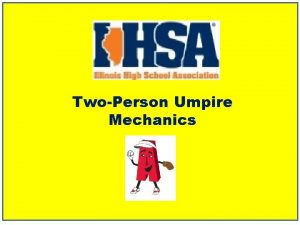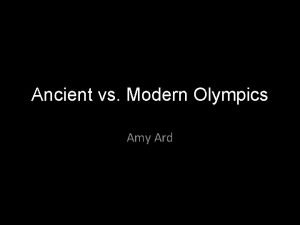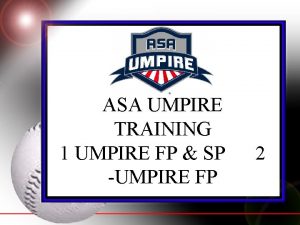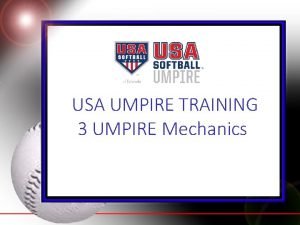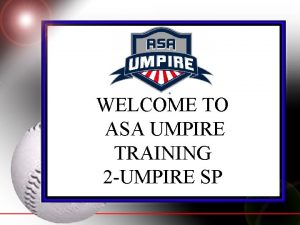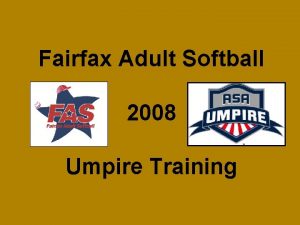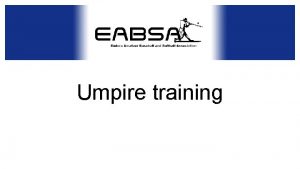Umpire Training Tips Home Plate Umpire As a







- Slides: 7

Umpire Training & Tips

Home Plate Umpire • As a home plate umpire, you are responsible for “calling the game” which includes the flow of the game. • You should also lead a pre-game discussion with the base umpire to assign call responsibilities. Often, the home plate umpire takes responsibility for: • Calling “fair” and “foul” • Calling fly ball outs • Calling a pulled foot at first base • Position yourself in the slot position. • This is the position just behind the catcher, in the open space between the batter and the inside corner of the plate. • Stand in an athletic position so you are able to move or react quickly. • See picture to the right.

Home Plate Umpire - continued • Calling balls and strikes • Generally speaking, the strike zone is the area over the plate between the armpits and knees of the batter. • Provide a generous strike zone, particularly for our younger, minors league. • Position your head at the top of the strike zone and track the ball with your eyes. • Maintain consistency in your strike zone throughout a game. • Your strike zone should be bigger at the beginning of the season and become somewhat smaller as pitchers improve. • Allow yourself time between the time your see the completed pitch and the time you make your call. • Make your call loud enough for both benches to hear and display confidence.

Base Umpire • It’s a good idea for beginner umpires to take base umpire assignments in order to learn from more experienced umpires. • Your primary responsibility is to call runners safe or out. • Your starting position will depend on which bases are occupied by runners. See the diagram below for reference. • No runners – start at slot A • Runner at 1 st base – start at slot B • Lead runner at 2 nd or 3 rd – start at slot C

Base Umpire - continued • The base umpire makes calls on all bases (not home plate), unless you make alternate arrangement with the home plate umpire. • Sometimes the home plate umpire will make calls at 3 rd base. • Make your call with arm signals and loud verbal signals. See video examples in the following website: http: //www. littleleagueumpiring 101. com/base-umpiring/making-a-call-on-runner/ • Other responsibilities • • • Runners leaving early (minors- before the ball crosses home plate) Runner touching bases Runner tagging up on fly ball Fielder standing in base path or “obstructing” runner Base runner “interfering” with fielder (that is making a play on the ball)

Other Umpire Tips • Favor angle over distance when making your call. • To aid in your decision, look for one outcome when making your call. • Did you see and out – if not, the runner is safe. • Did you see a strike – if not, it must be a ball. • Did you see a rule violation – if not, you’ve got no call. • Take your time making your call. • Make your call with confidence. • Before you start, take some time to look over the rules.

Rules Differences Between Majors and Minors Majors • Dropped 3 rd strike – Not • Dropped 3 rd strike – With <2 out applicable and 1 st base is unoccupied • Leading off – No allowed • Leading off – Allowed • Steals – Runner may steal once • Steals – Full steals allowed (not ball crosses home plate home) • Passes ball – Runner may NOT • Passed ball – Runner may advance home • Balks – Not applicable • Balks – One warning per pitcher. Unsportsmanlike conduct is not acceptable for either league – Usually one warning is given.
